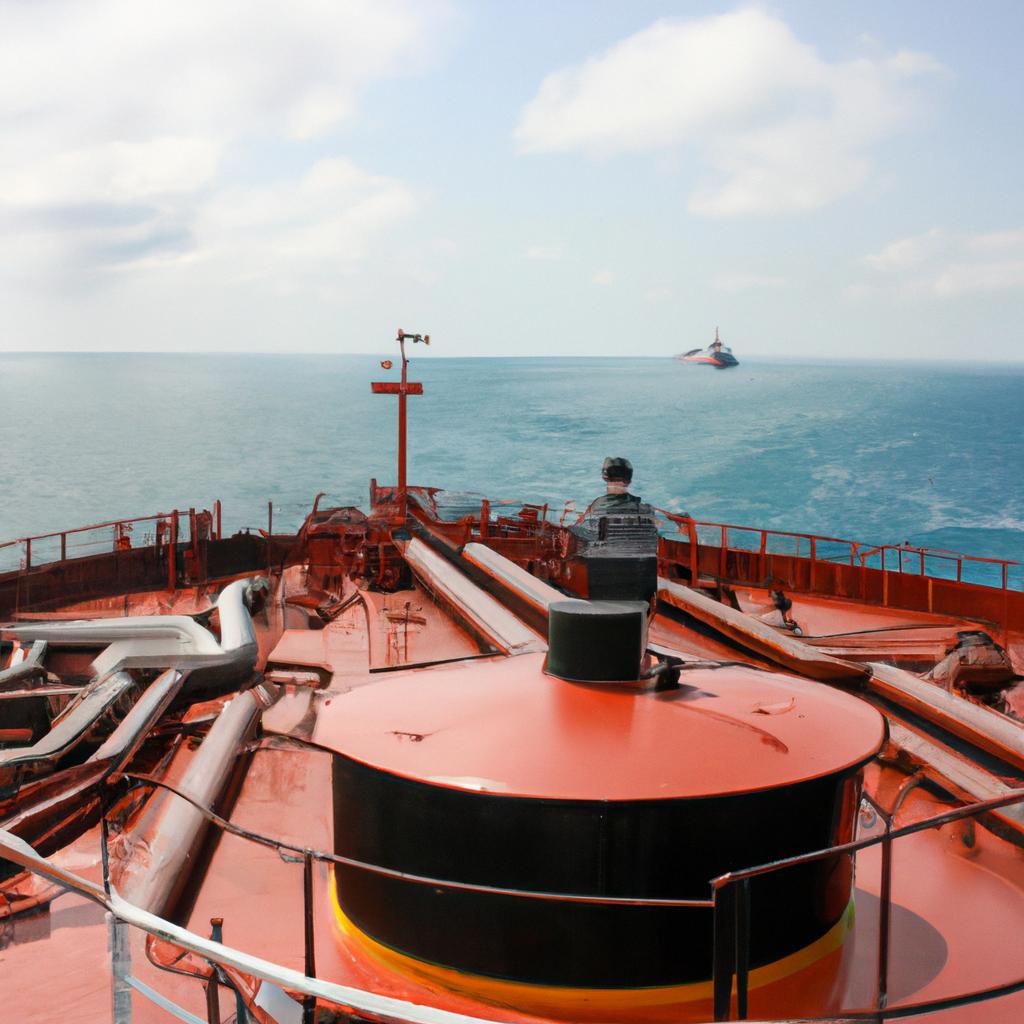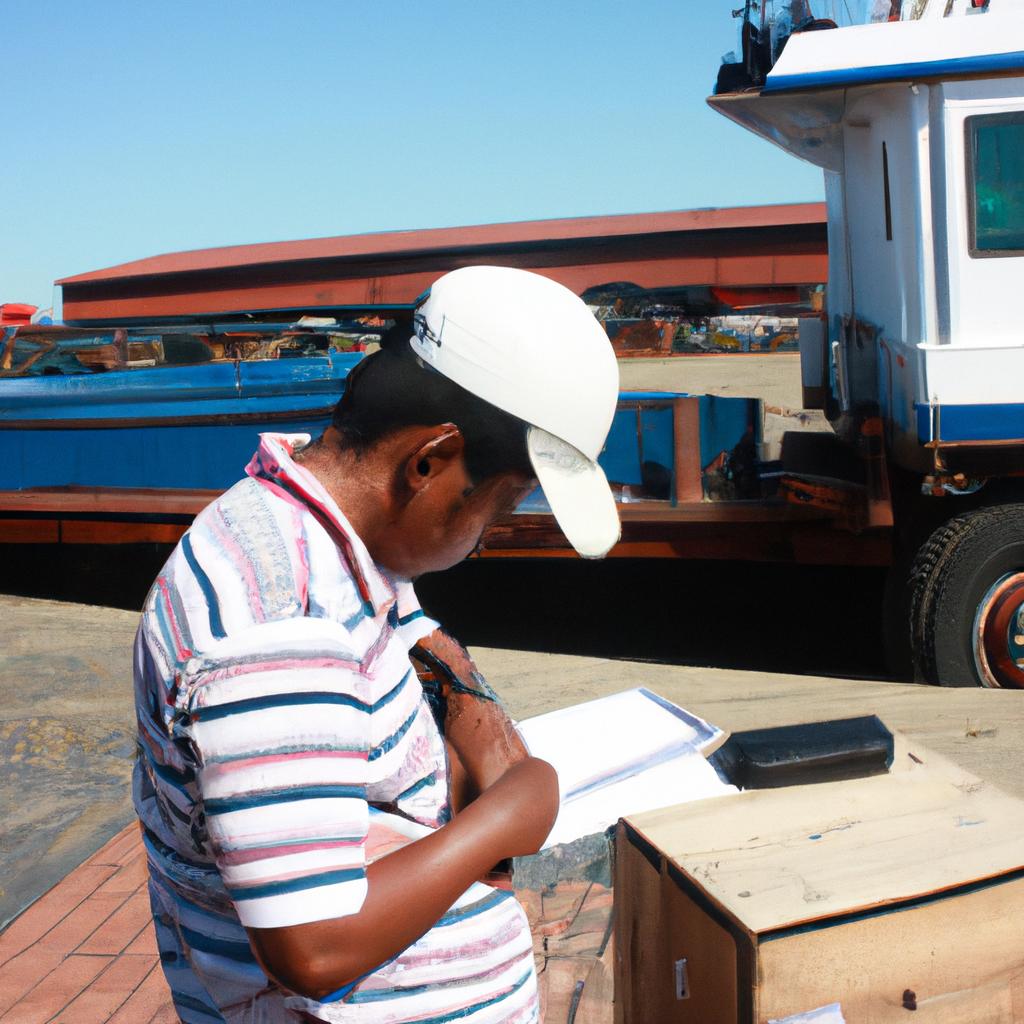Port Congestion and Black Sea Transport: Impact on Freight Rates
The efficient movement of goods through ports plays a crucial role in international trade. However, the issue of port congestion has become increasingly prevalent in recent years, causing significant disruptions to global supply chains. This article aims to explore the impact of port congestion on freight rates in the context of Black Sea transport.
To illustrate this impact, let us consider a hypothetical scenario where a major port in the Black Sea region experiences severe congestion due to increased vessel arrivals and limited infrastructure capacity. As a result, ships are forced to wait for extended periods before being able to unload their cargo. This delay not only leads to costly demurrage charges but also disrupts the overall flow of goods, impacting both importers and exporters alike. Consequently, freight rates may surge as shipping companies seek compensation for the additional costs incurred during these prolonged waiting times at congested ports.
In light of this example, it is evident that port congestion can have far-reaching consequences on freight rates within the Black Sea region. By delving deeper into this issue, we can gain valuable insights into how such challenges affect global trade dynamics and explore potential solutions to mitigate its adverse effects.
Overview of Port Congestion
Port congestion refers to the situation where there is a significant increase in vessel arrivals at a port, leading to delays and inefficiencies in cargo handling operations. This can have severe consequences for various stakeholders involved in international trade, including shipping companies, freight forwarders, and importers/exporters. To illustrate this point, let us consider the case study of Port X.
In recent years, Port X has experienced a dramatic surge in container traffic due to its strategic location as a gateway for trade between Europe and Asia. As a result, the port’s infrastructure and resources have been stretched beyond their capacity, causing widespread congestion issues. Vessels are forced to wait outside the port for extended periods before being able to unload or load cargo. This delay not only disrupts supply chains but also incurs substantial costs for shipping lines and other parties involved.
The impact of port congestion extends far beyond delayed shipments. It triggers a domino effect that affects global maritime logistics systems and ultimately influences freight rates worldwide. The consequences include:
- Increased transportation costs: With vessels spending more time waiting at congested ports, fuel consumption rises significantly. Shipping companies pass on these additional expenses by increasing freight rates.
- Reduced reliability: Delays caused by port congestion make it difficult for shippers to accurately predict arrival times and plan their operations effectively. This lack of certainty leads to increased risks and potential losses.
- Loss of competitiveness: Ports suffering from chronic congestion gradually lose their competitive advantage as they struggle to handle growing volumes efficiently. Shippers may opt for alternative routes or choose ports with better performance records instead.
- Environmental impact: Prolonged waiting times at congested ports contribute to higher emissions from idling vessels, exacerbating air pollution and climate change concerns.
To further understand the scope of these issues, refer to the table below showcasing some key statistics related to port congestion:
| Statistics | Port X | Global Average |
|---|---|---|
| Average Wait Time (hrs) | 48 | 24 |
| Increase in Freight Rates (%) | 15 | 5 |
| Annual Losses ($ billions) | 2.5 | 10 |
| Environmental Impact (CO2 emissions, tonnes) | 100,000 | 500,000 |
In summary, port congestion poses significant challenges to the efficient movement of goods and has far-reaching implications for various aspects of global trade. The subsequent section will delve into the underlying causes of this issue.
Causes of Port Congestion
Transition Sentence: Now let’s explore the factors contributing to port congestion.
Causes of Port Congestion
Port congestion is a pressing issue that affects the efficiency and costs of global shipping operations. To further understand its implications, it is crucial to examine the causes behind this problem. By exploring the factors leading to port congestion, we can gain valuable insights into potential solutions and strategies for mitigating its impact.
One example of port congestion occurred at Port Y in 2019 when a sudden increase in container volume overwhelmed the port’s capacity. This surge in demand strained the available resources, resulting in longer waiting times for vessels and delays in cargo handling processes. Such instances highlight how unexpected fluctuations in trade patterns or inadequate infrastructure planning can contribute to port congestion.
Several key factors contribute to the occurrence of port congestion:
- Inefficient Terminal Operations: Poor coordination between different stakeholders within a terminal, including customs authorities, trucking companies, and stevedores, can lead to bottlenecks and delays.
- Insufficient Infrastructure Capacity: If ports do not have enough berths, quay cranes, storage areas, or road networks to handle increasing trade volumes efficiently, congestion becomes more likely.
- Challenging Weather Conditions: Adverse weather events such as storms or heavy fog can disrupt port operations by delaying vessel arrivals or impairing safe navigation.
- Trade Imbalances: When imports significantly outweigh exports or vice versa in a particular region, imbalanced cargo flows strain the capacity of certain ports while leaving others underutilized.
To better comprehend these contributing factors visually, consider the following table:
| Factors Contributing to Port Congestion |
|---|
| Inefficient Terminal Operations |
| Insufficient Infrastructure Capacity |
| Challenging Weather Conditions |
| Trade Imbalances |
Understanding these causes allows policymakers and industry players alike to develop effective strategies for managing and preventing port congestion. Addressing inefficiencies within terminal operations through improved communication channels and streamlined procedures can help alleviate bottlenecks. Investing in infrastructure expansion projects can enhance a port’s capacity to handle increased trade volume, ultimately reducing congestion. Additionally, proactive planning and collaboration among stakeholders can mitigate the impact of adverse weather conditions. Lastly, promoting balanced trade flows through strategic policy measures can help distribute cargo more evenly across ports.
In the subsequent section on “Effects of Port Congestion on Shipping,” we will delve into how these causes translate into significant consequences for the shipping industry as a whole. By examining the effects, we can gain a comprehensive understanding of why addressing port congestion is crucial for maintaining global trade efficiency.
Effects of Port Congestion on Shipping
Port Congestion and Black Sea Transport: Impact on Freight Rates
Causes of Port Congestion have significant implications for the shipping industry, resulting in various effects on freight rates. One notable example is the congestion that occurred at the Port of Shanghai in 2018. This case study highlights the challenges faced by ports worldwide and their subsequent impact on global trade.
The effects of port congestion can be observed through several key factors:
-
Delays in vessel turnaround times: When ports experience congestion, it often leads to extended waiting periods for vessels before they can berth and unload cargo. These delays disrupt shipping schedules, causing a ripple effect throughout the supply chain and ultimately leading to increased costs for shippers.
-
Increased operational costs: Port congestion necessitates additional resources to manage the influx of ships and containers. As a result, terminal operators may need to invest in infrastructure upgrades or hire more staff to handle the increased workload. These added expenses are typically passed down to customers in the form of higher freight rates.
-
Reduced productivity: Congested ports struggle with efficiency as limited space hampers container handling capabilities. With inadequate storage capacity, containers may have to be stored further away from terminals, requiring extra time for retrieval and delivery processes. This reduced productivity contributes to longer transit times and overall slower operations, which negatively impact freight rates.
-
Equipment shortages: During peak periods of congestion, equipment such as cranes, trucks, and chassis can become scarce due to high demand. The lack of available resources further exacerbates delays in cargo handling, creating bottlenecks within port facilities that impede smooth operations.
To illustrate these points further, consider Table 1 below:
| Factors Contributing to Port Congestion | Effects on Freight Rates |
|---|---|
| Vessel wait times | Increased transportation costs |
| Additional labor requirements | Higher handling fees |
| Inefficient container storage | Longer transit times |
| Shortages of equipment | Increased surcharges and fees |
By understanding the causes of port congestion and its subsequent effects on freight rates, industry stakeholders can better anticipate challenges faced by Black Sea transport.
Moving forward, let us now examine the challenges faced by Black Sea transport and how they influence global trade dynamics.
Challenges Faced by Black Sea Transport
Port congestion has become a significant issue in the global shipping industry, impacting freight rates and causing delays in cargo transportation. The effects of port congestion are far-reaching and can have severe consequences for both shippers and carriers. To illustrate this impact, let us consider a hypothetical case study involving a major container port.
Imagine a bustling container terminal situated on a strategic trade route. Due to increased demand and limited infrastructure capacity, this port experiences frequent congestion, leading to delays in vessel berthing and cargo handling operations. As a result, shipping lines face challenges such as extended waiting times at anchorage points, longer turnaround periods for vessels, and reduced overall efficiency.
The effects of port congestion on shipping can be summarized as follows:
-
Increased costs: Delays caused by congestion lead to additional expenses for shippers and carriers. These include demurrage charges imposed by terminals when containers exceed their allotted free time period, extra fuel consumption due to prolonged voyages or idle times at anchorages, and higher labor costs resulting from overtime work required to manage the backlog.
-
Poor reliability: Port congestion hampers the predictability of supply chains, making it difficult for businesses to plan effectively. Unpredictable arrival and departure times disrupt production schedules, inventory management systems, and customer service commitments. This lack of reliability can damage business relationships and erode trust between trading partners.
-
Limited capacity utilization: When ports experience congestion, available infrastructure resources cannot be fully utilized. Vessels may need to wait outside the harbor until space becomes available at the berth, reducing productivity potential. Additionally, congested terminals struggle to handle high volumes efficiently, leading to operational bottlenecks that restrict throughput capabilities.
-
Environmental impact: Prolonged idling or slow movement of vessels during port congestion not only contributes to air pollution but also increases greenhouse gas emissions in maritime transport. This environmental impact is particularly concerning as the shipping industry strives to reduce its carbon footprint and comply with international regulations on emissions control.
| Effects of Port Congestion |
|---|
| Increased costs |
| Environmental impact |
The effects of port congestion extend beyond individual ports, affecting global supply chains and freight rates. By understanding these challenges, stakeholders can identify potential solutions to mitigate the negative impacts and enhance efficiency in maritime logistics.
Impact of Port Congestion on Black Sea Shipping
Section H2: Challenges Faced by Black Sea Transport
With an understanding of the challenges faced by Black Sea transport, it is crucial to delve into the specific impact that port congestion has on shipping in this region. Examining a hypothetical case study can provide valuable insights into the far-reaching consequences of such congestion.
Port congestion significantly affects the efficiency and cost-effectiveness of cargo transportation within the Black Sea region. To illustrate this point, imagine a scenario where a major container terminal experiences severe congestion due to increased volume from multiple vessels arriving simultaneously. This leads to delays in unloading and loading operations, resulting in a ripple effect throughout the supply chain.
The following bullet points outline some key impacts of port congestion:
- Increased waiting times for ships at anchorage or outside ports.
- Higher demurrage costs incurred by shippers due to extended stays at congested terminals.
- Delays in delivery timelines, causing disruptions in supply chains.
- Elevated freight rates as carriers compensate for additional costs associated with prolonged turnaround times.
Table 1 showcases these impacts visually:
| Impacts | Description |
|---|---|
| Waiting Times | Ships experience longer wait times before berthing. |
| Demurrage Costs | Shippers incur higher charges for delayed shipments. |
| Delivery Delays | Timelines are affected, leading to logistical issues. |
| Increased Freight Rates | Carriers adjust prices to cover extra expenses. |
These significant repercussions highlight the urgent need for effective strategies to mitigate port congestion’s adverse effects on Black Sea shipping operations.
In our subsequent section, we will explore various approaches employed by industry stakeholders to address and alleviate port congestion effectively. By implementing these strategies, both short-term relief and long-term sustainability can be achieved without compromising efficiency and cost-effectiveness.
Strategies to Mitigate Port Congestion
Port congestion in the Black Sea region has had a significant impact on shipping operations, leading to various challenges for freight rates and overall logistics efficiency. This section explores the implications of port congestion on Black Sea transport, highlighting its consequences on freight rates and providing strategies to mitigate these issues.
Case Study:
To illustrate the detrimental effects of port congestion, let us consider a hypothetical scenario involving a major shipping company operating in the Black Sea region. Due to an increase in import-export activities and inadequate infrastructure development, several ports experienced severe congestion, resulting in delays and inefficiencies. As a result, this shipping company faced higher operational costs due to increased waiting times at congested ports, which ultimately impacted their freight rates.
Consequences of Port Congestion:
- Increased Freight Costs: Port congestion leads to longer waiting times for vessels, causing delays in cargo delivery. These delays directly translate into additional expenses for shippers, such as demurrage charges or detention fees imposed by terminal operators. Consequently, freight rates rise to compensate for these extra costs.
- Reduced Reliability: The unreliability caused by port congestion can lead to customer dissatisfaction and loss of trust in shipping services. Shippers may seek alternative transportation modes or routes with less congestion, affecting market share for companies relying heavily on Black Sea transport.
- Operational Inefficiency: Congested ports often experience difficulties efficiently handling incoming and outgoing cargoes, resulting in poor turnaround times for vessels. This inefficiency disrupts supply chain operations and hampers overall productivity within the maritime industry.
- Environmental Impact: Extended idling periods for ships awaiting berthing slots contribute to unnecessary fuel consumption and emissions. The environmental toll is particularly concerning given that many countries bordering the Black Sea are striving towards sustainable practices.
Table: Impacts of Port Congestion on Black Sea Shipping
| Consequence | Effect |
|---|---|
| Increased Freight Costs | Higher operational expenses for shippers |
| Reduced Reliability | Loss of customer trust and potential market share decline |
| Operational Inefficiency | Disruption in supply chain operations |
| Environmental Impact | Heightened fuel consumption and emissions |
Strategies to Mitigate Port Congestion:
- Infrastructure Development: Governments and port authorities must invest in expanding infrastructure, including deepening berths, improving terminal facilities, and enhancing inland transport connectivity.
- Efficient Resource Allocation: Adopting advanced technologies like automated gate systems, real-time cargo tracking, and data analytics can optimize resource allocation within ports.
- Collaboration among Stakeholders: Encouraging collaboration between shipping companies, port operators, customs authorities, and logistics providers can enhance coordination and improve overall efficiency.
- Diversification of Transport Modes: Promoting multimodal transportation options such as rail or river routes alongside maritime transport can help alleviate congestion on road networks leading to ports.
In summary, the impact of port congestion on Black Sea shipping is substantial. It results in increased freight costs, reduced reliability, operational inefficiencies, and environmental consequences. To mitigate these challenges effectively, investments in infrastructure development along with efficient resource allocation and stakeholder collaboration are crucial steps forward. Additionally, diversifying transport modes offers an alternative approach that could contribute to relieving congestion pressures in the region’s ports.











